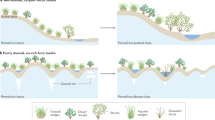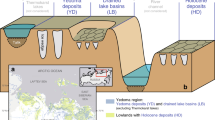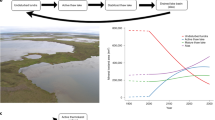Abstract
Arctic tundra ecosystems are warming almost twice as fast as the global average1. Permafrost thaw and the resulting release of greenhouse gases from decomposing soil organic carbon have the potential to accelerate climate warming2,3. In recent decades, Arctic tundra ecosystems have changed rapidly4, including expansion of woody vegetation5,6, in response to changing climate conditions. How such vegetation changes contribute to stabilization or destabilization of the permafrost is unknown. Here we present six years of field observations in a shrub removal experiment at a Siberian tundra site. Removing the shrub part of the vegetation initiated thawing of ice-rich permafrost, resulting in collapse of the originally elevated shrub patches into waterlogged depressions within five years. This thaw pond development shifted the plots from a methane sink into a methane source. The results of our field experiment demonstrate the importance of the vegetation cover for protection of the massive carbon reservoirs stored in the permafrost and illustrate the strong vulnerability of these tundra ecosystems to perturbations. If permafrost thawing can more frequently trigger such local permafrost collapse, methane-emitting wet depressions could become more abundant in the lowland tundra landscape, at the cost of permafrost-stabilizing low shrub vegetation.
This is a preview of subscription content, access via your institution
Access options
Subscribe to this journal
Receive 12 print issues and online access
$209.00 per year
only $17.42 per issue
Buy this article
- Purchase on Springer Link
- Instant access to full article PDF
Prices may be subject to local taxes which are calculated during checkout




Similar content being viewed by others
References
IPCC Climate Change 2013: The Physical Science Basis (eds Stocker, T. F. et al.) (Cambridge Univ. Press, 2013).
Tarnocai, C. et al. Soil organic carbon pools in the northern circumpolar permafrost region. Glob. Biogeochem. Cycles 23, GB2023 (2009).
Schuur, E. A. G. et al. The effect of permafrost thaw on old carbon release and net carbon exchange from tundra. Nature 459, 556–559 (2009).
Hinzman, L. D. et al. Trajectory of the Arctic as an integrated system. Ecol. Appl. 23, 1837–1868 (2013).
Tape, K., Sturm, M. & Racine, C. The evidence for shrub expansion in Northern Alaska and the Pan-Arctic. Glob. Change Biol. 12, 686–702 (2006).
Elmendorf, S. C. et al. Plot-scale evidence of tundra vegetation change and links to recent summer warming. Nature Clim. Change 2, 453–457 (2012).
Romanovsky, V. E., Smith, S. L. & Christiansen, H. H. Permafrost thermal state in the polar Northern Hemisphere during the International Polar Year 2007–2009: A Synthesis. Permaf. Periglac. Process. 21, 106–116 (2010).
Walker, D. A. et al. Vegetation-soil-thaw-depth relationships along a Low-Arctic bioclimate gradient, Alaska: Synthesis of information from the ATLAS studies. Permaf. Periglac. Process. 14, 103–123 (2003).
Jorgenson, M. T. et al. Resilience and vulnerability of permafrost to climate change. Can. J. For. Res. 40, 1219–1236 (2010).
Blok, D. et al. Shrub expansion may reduce summer permafrost thaw in Siberian tundra. Glob. Change Biol. 16, 1296–1305 (2010).
Bret-Harte, M. S. et al. Developmental plasticity allows Betula nana to dominate tundra subjected to an altered environment. Ecology 82, 18–32 (2001).
Van Huissteden, J., Maximov, T. C. & Dolman, A. J. High methane flux from an Arctic floodplain (Indigirka lowlands, eastern Siberia). J. Geophys. Res. 110, G02002 (2005).
Elberling, B. et al. Linking soil O2, CO2, and CH4 concentrations in a wetland soil: Implications for CO2 and CH4 fluxes. Environ. Sci. Technol. 45, 3393–3399 (2011).
Blok, D. et al. The response of Arctic vegetation to the summer climate: Relation between shrub cover, NDVI, surface albedo and temperature. Environ. Res. Lett. 6, 035502 (2011).
Kanevskiy, M. et al. Ground ice in the upper permafrost of the Beaufort Sea coast of Alaska. Cold Reg. Sci. Tech. 85, 56–70 (2013).
Sturm, M. et al. Snow-shrub interactions in Arctic tundra: A hypothesis with climatic implications. J. Clim. 14, 336–344 (2001).
Zhang, T. J. et al. Spatial and temporal variability in active layer thickness over the Russian Arctic drainage basin. J. Geophys. Res. 110, D16101 (2005).
Helbig, M. et al. Spatial and seasonal variability of polygonal tundra water balance: Lena River Delta, northern Siberia (Russia). Hydrogeol. J. 21, 133–147 (2013).
Shiklomanov, N. I. et al. Decadal variations of active-layer thickness in moisture-controlled landscapes, Barrow, Alaska. J. Geophys. Res. 115, G00I04 (2010).
Brown, J., Ferrians, O., Heginbottom, J. A. & Melnikov, E. Circum-Arctic Map of Permafrost and Ground-Ice Conditions Version 2 (National Snow and Ice Data Center, 2002); http://nsidc.org/data/ggd318.html
Nelson, F. E., Anisimov, O. A. & Shiklomanov, N. I. Subsidence risk from thawing permafrost. Nature 410, 889–890 (2001).
Elberling, B. et al. Long-term CO2 production following permafrost thaw. Nature Clim. Change 3, 890–894 (2013).
Shur, Y. L. & Jorgenson, M. T. Patterns of permafrost formation and degradation in relation to climate and ecosystems. Permaf. Periglac. Process. 18, 7–19 (2007).
Grosse, G. et al. Vulnerability of high-latitude soil organic carbon in North America to disturbance. J. Geophys. Res. 116, G00K06 (2011).
Olofsson, J., Ericson, L., Torp, M., Stark, S. & Baxter, R. Carbon balance of Arctic tundra under increased snow cover mediated by a plant pathogen. Nature Clim. Change 1, 220–223 (2011).
Smith, L. C., Sheng, Y., MacDonald, M. & Hinzman, L. D. Disappearing Arctic lakes. Science 308, 1429 (2005).
Jorgenson, M. T., Shur, Y. L. & Pullman, E. R. Abrupt increase in permafrost degradation in Arctic Alaska. Geophys. Res. Lett. 33, L02503 (2006).
Raynolds, M. K. et al. Cumulative geoecological effects of 62 years of infrastructure and climate change in ice-rich permafrost landscapes, Prudhoe Bay Oilfield, Alaska. Glob. Change Biol. 20, 1211–1224 (2014).
Myers-Smith, I. H. et al. Shrub expansion in tundra ecosystems: Dynamics, impacts and research priorities. Environ. Res. Lett. 6, 045509 (2011).
Van Huissteden, J. & Dolman, A. J. Soil carbon in the Arctic and the permafrost carbon feedback. Curr. Opin. Environ. Sustain. 4, 545–551 (2012).
Acknowledgements
We thank T. Strukova, S. Ianygin, A. Kononov, D. Suzdalov and S. Karsanaev for logistic support and assistance at the field site. We acknowledge support by Darwin Center for Biogeosciences (projects 1043 and 3052), The Netherlands Organisation for Scientific Research (Vidi-project 864.09.014), Wageningen Institute for Environment and Climate Research (WIMEK), Danish National Research Foundation (CENPERM DNRF100) and the EU Seventh Framework Programme (FP7/2007-2013).
Author information
Authors and Affiliations
Contributions
F.B., M.M.P.D.H., D.B. and A.L.N. conceived the project; all authors contributed to the field work; A.L.N. and D.B. analysed the data; M.M.P.D.H., A.L.N., D.B. and J.L. wrote the manuscript with contributions from B.E., F.B. and J.v.H.
Corresponding author
Ethics declarations
Competing interests
The authors declare no competing financial interests.
Supplementary information
Rights and permissions
About this article
Cite this article
Nauta, A., Heijmans, M., Blok, D. et al. Permafrost collapse after shrub removal shifts tundra ecosystem to a methane source. Nature Clim Change 5, 67–70 (2015). https://doi.org/10.1038/nclimate2446
Received:
Accepted:
Published:
Issue Date:
DOI: https://doi.org/10.1038/nclimate2446
This article is cited by
-
Aerosols, Clusters, Greenhouse Gases, Trace Gases and Boundary-Layer Dynamics: on Feedbacks and Interactions
Boundary-Layer Meteorology (2023)
-
Effects of snow manipulation on larch trees in the taiga forest ecosystem in northeastern Siberia
Progress in Earth and Planetary Science (2022)
-
Tundra vegetation change and impacts on permafrost
Nature Reviews Earth & Environment (2022)
-
Permafrost carbon emissions in a changing Arctic
Nature Reviews Earth & Environment (2022)
-
Thermodynamic basis for the demarcation of Arctic and alpine treelines
Scientific Reports (2022)



